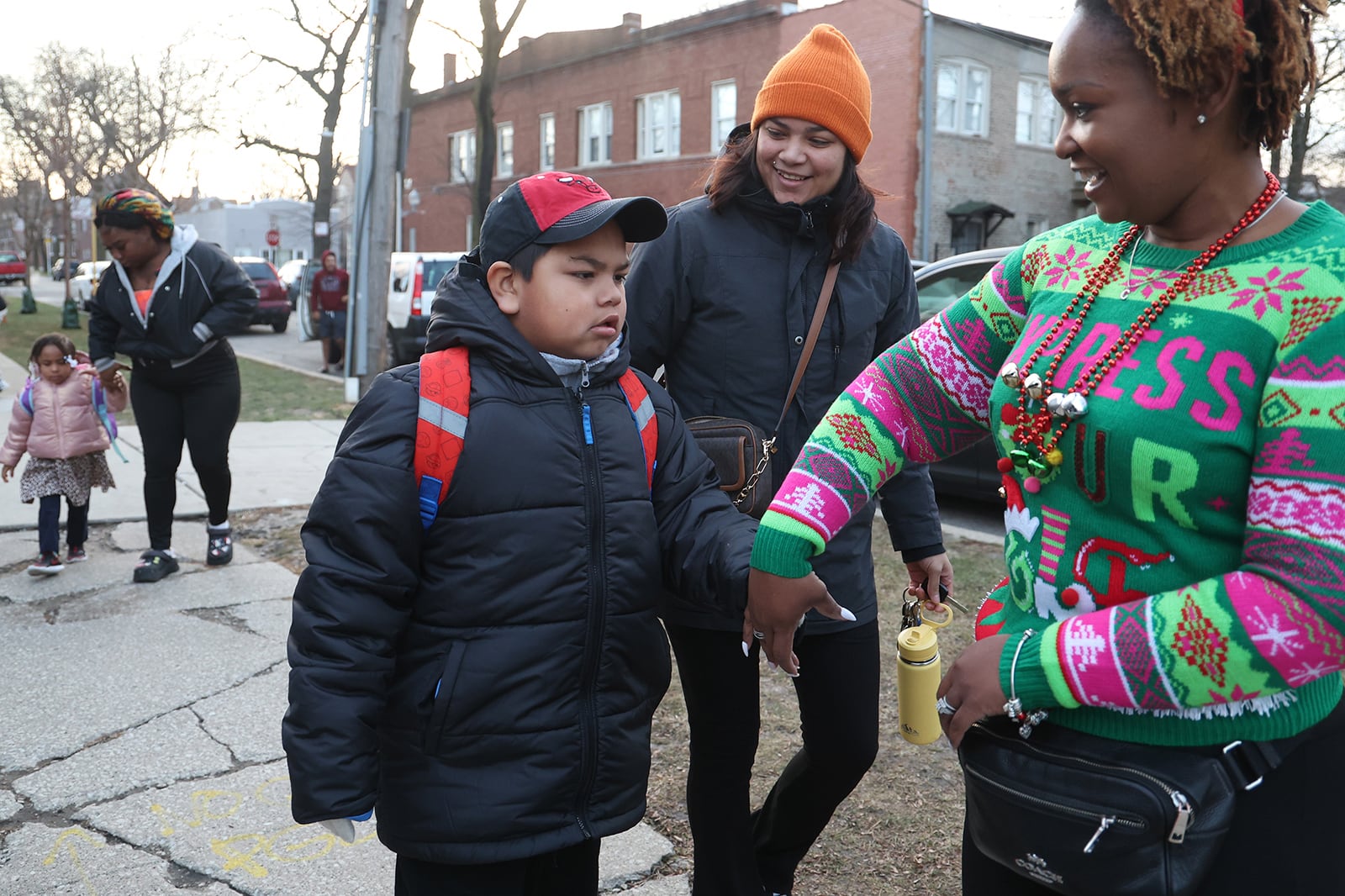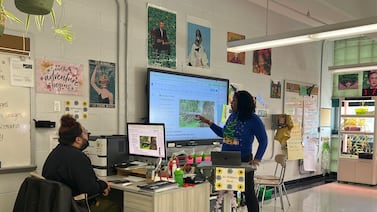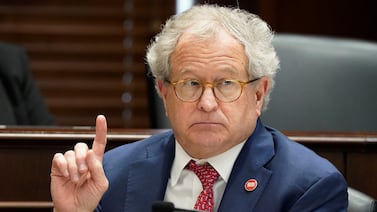Sign up for Chalkbeat Chicago’s free daily newsletter to keep up with the latest news on Chicago Public Schools.
Data analysis by Thomas Wilburn
Changes in how Chicago Public Schools staffs its special education programs are coming under intense scrutiny as the district grapples with a $734 million deficit for the coming school year.
The Chicago Teachers Union and SEIU Local 73, which represent special education classroom assistants, held separate rallies last week protesting possible cuts to the ranks of educators and support staff serving students with disabilities.
But district officials say the changes aim to address longstanding staffing imbalances in which CPS has overallocated employees serving students with disabilities to some schools, while others have struggled to fill these roles amid a national special education staffing shortage.
After adding thousands of staff positions in recent years, CPS leaders said the number of special education teachers and the overall budget for special education are poised to grow again. Special education classroom assistant positions will likely decrease, but “an overwhelming majority” of affected employees will be able to find a job at a different school because of widespread vacancies, officials said.
“The changes that we’re making are unequivocally unrelated to any budgetary pressures or budgetary cuts,” said Mike Sitkowski, the district’s chief budget officer. “Our commitment as a district, and my commitment personally has been to make sure that we have the resources we need in place for our students with disabilities that we’re legally and morally obligated to provide.”
But labor leaders say they remain wary of the changes, which they argue the district made without enough staff and family input. They say that shifting special education teachers and support staff among schools will be disruptive for students with disabilities, who tend to thrive on consistency.
“SECAs develop a rapport with students,” said Trumaine Reeves, SEIU’s CPS division director. “They get them to open up and get on the right track.”
The number of students with IEPs the district serves increased almost 8% in the past five years to about 53,500 students last year after dipping during the pandemic. During that same period, the number of special education teacher positions grew 26% to about 5,300 this spring, and the number of SECA roles rose more than 60% to 7,455, according to a Chalkbeat analysis of district staffing data. But hundreds of these positions go unfilled each year, often in schools serving low-income students with the highest needs.
This coming school year, the district will add 120 case managers in keeping with its new teachers contract, which officials said will lead to more manageable workloads for educators. It will also staff 100 more clinicians, such as speech pathologists, occupational therapists, psychologists, and others. It will launch more than 30 new cluster programs, for students with significant disabilities, in a move officials said will improve access to specialized services.
Amid a changeover in its top leadership, CPS is still at work on its 2025-26 budget, which officials say they’ll likely unveil in early August — much later than usual and weeks after the July 1 start of the fiscal year. The district announced dozens of layoffs and vacant position cuts last week, most of them in the central office, and more reductions might be coming as the district wrestles with its deficit. Some school leaders and employees have said the uncertainty this close to the start of the school year has created a lot of anxiety, especially among special education teachers, support staff, and families.
CPS says changes will help address vacancies
But district leaders insisted in an interview with Chalkbeat Chicago that they would still make the recent changes to how they assign staff serving students with disabilities even if they had a blank check. Overall special education funding will increase from the current $1.3 billion even before factoring in employee raises, though officials couldn’t say by how much before the overall district budget is set.
They said they worked with real-time enrollment and staffing data to ensure that teachers and support staff are placed in the schools and classrooms where they are needed. They said they used enrollment numbers from the end of this past school year — a time when these numbers peaked — reflecting an annual increase of thousands of students qualifying for special education services over the course of the year.
Joshua Long, who leads the district’s Office for Students With Disabilities, said that while some schools, particularly on the South and West Sides, struggle with perennial vacancies for special education teachers and support staff, others have overstaffed these positions. He said he set out to address such staffing imbalances when he took over in late 2023 after serving as a principal at a specialized CPS high school for students with disabilities. He contrasted one network of schools on the city’s North Side with a 2% vacancy rate for special education teachers with another on the South Side where almost 20% of these roles are unfilled.
The district now has more than 360 vacant special education teacher positions and 400 vacant special education classroom assistant posts. The district’s new approach will better ensure that educators and support staff work on the campuses where they are truly needed, he says. Some campuses are losing special education teaching positions this fall, but their number overall will likely tick up, or at least remain stable, officials said.
“We as a district have to make sure that we have a formula that is equitable so we’re not further perpetuating these systemic vacancies and then denying students the services that they need,” Long told Chalkbeat.
The district will have fewer shared assistants in cluster programs
Another shift will reduce the start-of-the-year number of special education classroom assistants that the district staffs in its cluster programs, which serve exclusively students with significant disabilities. State guidelines call on districts to assign one assistant to classrooms with up to 13 students with special needs. But CPS has staffed at least two in each cluster class, where some students also have assistants assigned to work with them one-on-one. This coming school year, it will staff one per classroom, except in 32 new cluster programs the district is launching in the fall, to ensure a strong start.
Leaders and members of SEIU 73 and the CTU bashed the district over the shift at their rallies last week. They said that it is reverting to a state standard that reflects a “bare minimum” of staffing set by state officials who haven’t spent time in a special education classroom, in the words of Jeannine Carrasquillo, a special education classroom assistant at Henderson Elementary who has served in the role for more than two decades. Students in these classrooms often have intense behavioral and academic needs, and they require additional adults, not fewer.
Reeves, the SEIU division director at CPS, said the pandemic-era teacher and assistant increases addressed longstanding special education understaffing. They came after a damning 2018 report detailing the district’s lapses in providing services to students disabilities led the state to place it under a special monitor. He said staffing imbalances among schools in the district are a problem. But his union was “blindsided” by the new staffing changes, and he questioned if families had a chance to weigh in on them.
“I wish there had been an opportunity to discuss and collaborate on this issue,” he said. “I don’t think the answer to a problem is to create a bigger problem.”
Long said research has shown that more adults in the classroom aren’t better for students with disabilities. What the district called “over-adulted environments” can result in less student independence and less interaction with other students, including peers without disabilities.
Barbara Cohen, a policy analyst with the nonprofit Legal Council for Health Justice who advocates for students with disabilities in CPS, said adults can get in the way of efforts to help students with disabilities become more independent. Cohen, who also consults for the Chicago Teachers Union, said the issue often isn’t the presence of too many adults, but rather a lack of proper training in how they can help students navigate the classroom without being overbearing.
“I don’t think the solution is necessarily to cut the number of paraprofessionals,” she said. “The solution is to have teachers and support staff who understand better what effective support of students looks like.”
Cohen said she applauds new onboarding training for special education classroom assistants the district launched last summer. She would like to see even more of it: “You need ongoing support to be an effective SECA.”
The CTU has also flagged communications from the district letting school leaders know that in some cases, they could seek exemptions to a state rule that in most cases, no more than 30% percent of students in general education classrooms have disabilities. The district said most classrooms will continue to meet that requirement, but some schools need extra flexibility. The union has asked teachers to report cases when their schools ask for these exemptions and vowed to push back.
Mila Koumpilova is Chalkbeat Chicago’s senior reporter covering Chicago Public Schools. Contact Mila at mkoumpilova@chalkbeat.org.






